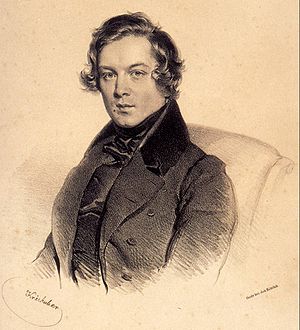
Novelletten Op. 21 (Schumann)
Encyclopedia

Robert Schumann
Robert Schumann, sometimes known as Robert Alexander Schumann, was a German composer, aesthete and influential music critic. He is regarded as one of the greatest and most representative composers of the Romantic era....
in 1838.
Background
The Novelletten were composed during February 1838, a period of great struggle for the composer. Schumann originally intended the eight pieces to be performed together as a group however they are often performed separately with great success.This set of pieces is an excellent example of Schumann's keyboard style.
No. 1 in F major
This piece contains 5 sections, alternating between a staccatoStaccato
Staccato is a form of musical articulation. In modern notation it signifies a note of shortened duration and separated from the note that may follow by silence...
march
March (music)
A march, as a musical genre, is a piece of music with a strong regular rhythm which in origin was expressly written for marching to and most frequently performed by a military band. In mood, marches range from the moving death march in Wagner's Götterdämmerung to the brisk military marches of John...
and flowing legato
Legato
In musical notation the Italian word legato indicates that musical notes are played or sung smoothly and connected. That is, in transitioning from note to note, there should be no intervening silence...
passages.
No. 2 in D major
This virtuosicVirtuoso
A virtuoso is an individual who possesses outstanding technical ability in the fine arts, at singing or playing a musical instrument. The plural form is either virtuosi or the Anglicisation, virtuosos, and the feminine form sometimes used is virtuosa...
piece is graceful and effective. An Intermezzo section in the middle contrasts and varies the piece.
No. 3 in D major
This piece displays the composer's sense of humour through the use of rapid staccato chords. An IntermezzoIntermezzo
In music, an intermezzo , in the most general sense, is a composition which fits between other musical or dramatic entities, such as acts of a play or movements of a larger musical work...
section in the middle of the piece is used to contrast.
No. 4 in D major
This piece is quite loosely organized in terms of structure however it is an interesting waltzWaltz
The waltz is a ballroom and folk dance in time, performed primarily in closed position.- History :There are several references to a sliding or gliding dance,- a waltz, from the 16th century including the representations of the printer H.S. Beheim...
that used cross-rhythms and syncopation
Syncopation
In music, syncopation includes a variety of rhythms which are in some way unexpected in that they deviate from the strict succession of regularly spaced strong and weak but also powerful beats in a meter . These include a stress on a normally unstressed beat or a rest where one would normally be...
effectively.
No. 5 in D major
This piece is in the form of a polonaisePolonaise
The polonaise is a slow dance of Polish origin, in 3/4 time. Its name is French for "Polish."The polonaise had a rhythm quite close to that of the Swedish semiquaver or sixteenth-note polska, and the two dances have a common origin....
; its principal section contains three main ideas which are then overcome by the persistent rhythms of the Trio section.
No. 6 in A major
This piece uses an increasing tempoTempo
In musical terminology, tempo is the speed or pace of a given piece. Tempo is a crucial element of any musical composition, as it can affect the mood and difficulty of a piece.-Measuring tempo:...
to characterize the progression of sections. Starting from the staccato opening, each of the following passages are marked a few metronome beats faster until the coda
Coda (music)
Coda is a term used in music in a number of different senses, primarily to designate a passage that brings a piece to an end. Technically, it is an expanded cadence...
, which returns to the original tempo.
No. 7 in E major
This piece features a beautiful and lyrical middle section; it also features many virtuosic passages containing fast, brilliant octaveOctave
In music, an octave is the interval between one musical pitch and another with half or double its frequency. The octave relationship is a natural phenomenon that has been referred to as the "basic miracle of music", the use of which is "common in most musical systems"...
s.
No. 8 in F sharp minor
The concluding piece of the set, is actually two pieces in one. The first part is a passionate etudeÉtude
An étude , is an instrumental musical composition, most commonly of considerable difficulty, usually designed to provide practice material for perfecting a particular technical skill. The tradition of writing études emerged in the early 19th century with the rapidly growing popularity of the piano...
in 2/4, the second has the nature of a march.

